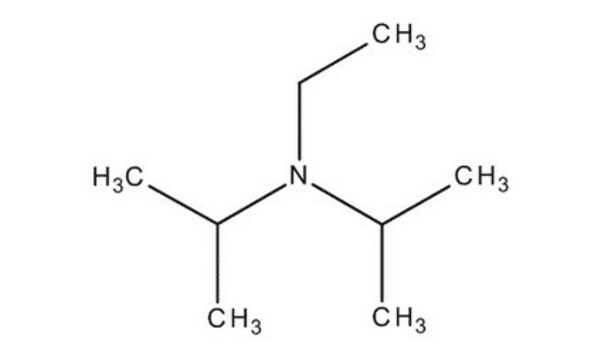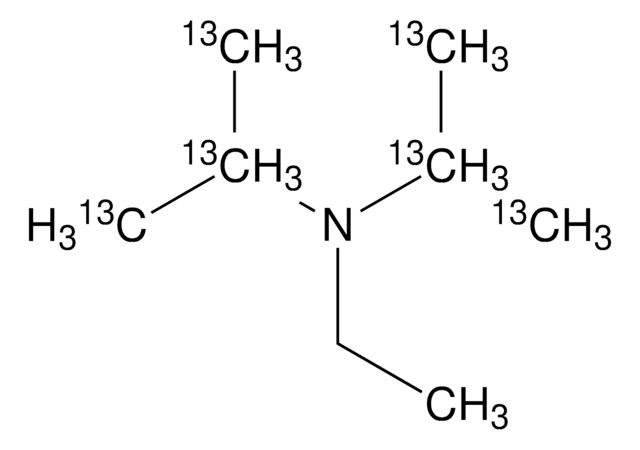推荐产品
等級
biotech. grade
品質等級
蒸汽壓力
31 mmHg ( 37.7 °C)
化驗
99.5%
形狀
liquid
雜質
<0.050% water
顏色
APHA: <20
折射率
n20/D 1.414 (lit.)
pH值
12.3 (20 °C)
bp
127 °C (lit.)
mp
<−50 °C (lit.)
溶解度
water: soluble 4.01 g/L at 20 °C
密度
0.742 g/mL at 25 °C (lit.)
應用
peptide synthesis
SMILES 字串
CCN(C(C)C)C(C)C
InChI
1S/C8H19N/c1-6-9(7(2)3)8(4)5/h7-8H,6H2,1-5H3
InChI 密鑰
JGFZNNIVVJXRND-UHFFFAOYSA-N
正在寻找类似产品? 访问 产品对比指南
一般說明
N, N-二异丙基乙胺是一种受阻的非亲核胺基碱,用于烷基化、醛类反应、消除和选择性生成烯醇酸。它被广泛用作有机合成中的质子清除剂。由于其亲核性较低,它产生的副产物较少。
N, N-二异丙基乙胺是一种受阻的非亲核胺基碱,用于烷基化、醛类反应、消除和选择性生成烯醇酸。它被广泛用作有机合成中的质子清除剂。由于其亲核性较低,它产生的副产物较少。
應用
N, N-二异丙基乙胺可作为碱用于:
- 钯(0)-催化烯丙基磷酸酯和乙酸酯的烷氧基羰基化反应。
- 和三氟甲磺酸硼酸酯一起选择性形成烯醇化物。
- 在镍催化剂参与下芳基卤化物与硝基芳烃的的C–N偶联反应。
N,N-二异丙基乙胺可用于甘露醇化卵清蛋白肽的合成。
訊號詞
Danger
危險分類
Acute Tox. 3 Inhalation - Acute Tox. 4 Oral - Aquatic Chronic 2 - Eye Dam. 1 - Flam. Liq. 2 - STOT SE 3
標靶器官
Respiratory system
儲存類別代碼
3 - Flammable liquids
水污染物質分類(WGK)
WGK 2
閃點(°F)
49.1 °F
閃點(°C)
9.5 °C
其他客户在看
Lipase-catalysed synthesis of olvanil in organic solvents.
Reyes-Duarte D, et al.
Biotechnology Letters, 24(24), 2057-2061 (2002)
Facile and Gram-scale Synthesis of Metal-free Catalysts: Toward Realistic Applications for Fuel Cells.
Kim OH, et al.
Scientific Reports, 5 (2015)
Asymmetric Hydrogenation of α,β-Unsaturated Nitriles with Base-Activated Iridium N, P Ligand Complexes
Muller MA and Pfaltz A.
Angewandte Chemie (International Edition in English), 126(33), 8812-8815 (2014)
Alexandre Yersin et al.
Biophysical journal, 94(1), 230-240 (2007-09-18)
Interaction between the iron transporter protein transferrin (Tf) and its receptor at the cell surface is fundamental for most living organisms. Tf receptor (TfR) binds iron-loaded Tf (holo-Tf) and transports it to endosomes, where acidic pH favors iron release. Iron-free
Irina Naletova et al.
Cancers, 11(9) (2019-09-11)
Angiogenin (ANG), an endogenous protein that plays a key role in cell growth and survival, has been scrutinised here as promising nanomedicine tool for the modulation of pro-/anti-angiogenic processes in brain cancer therapy. Specifically, peptide fragments from the putative cell
我们的科学家团队拥有各种研究领域经验,包括生命科学、材料科学、化学合成、色谱、分析及许多其他领域.
联系技术服务部门













